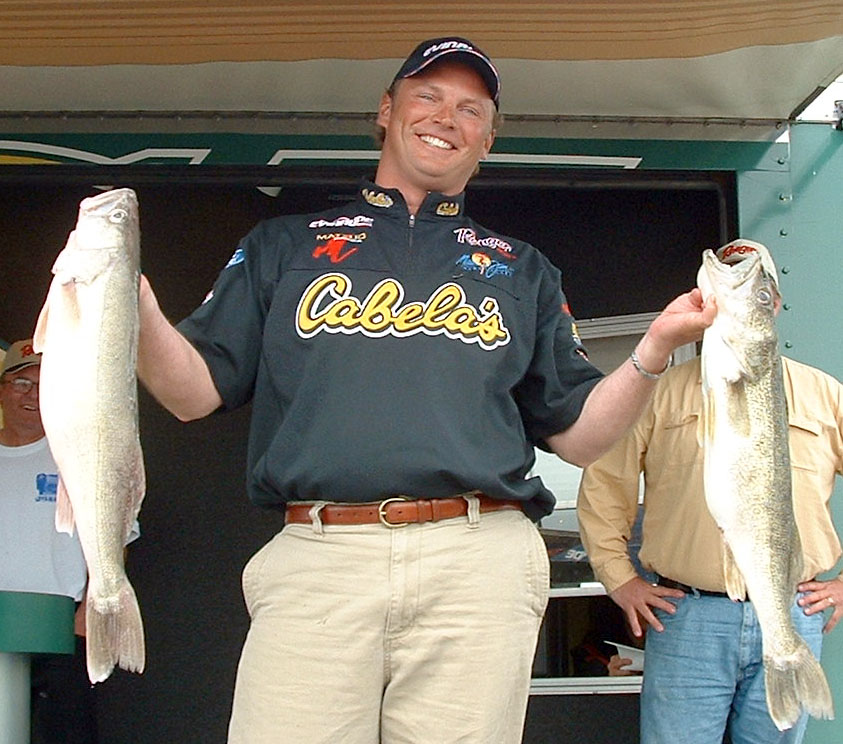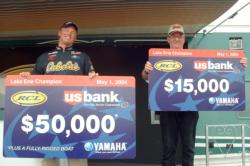Two-timing walleye
Grunwaldt finds fish, relocates, gets them to go with twin rigs on each line to win RCL Tour event on Erie

PORT CLINTON, Ohio – With the consistency of three consecutive 30-pound bags – not four due to a day lost to high winds – Ranger pro Carl Grunwaldt of Green Bay, Wis., scaled the ladder to its pinnacle Saturday, winning the Wal-Mart RCL Walleye Tour event on Lake Erie.
Demonstrating his trolling acumen and the resourcefulness to tweak a setup that employed two lures on one line, Grunwaldt piled 30 pounds, 13 ounces on top of his lead from the semifinals to earn $50,000 and a fully rigged Ranger boat with a Yamaha outboard.
In doing so, Grunwaldt outpaced the second-place finisher, 2003 RCL Angler of the Year Jason Przekurat of Stevens Point, Wis., by 6 pounds, 2 ounces over days three and four.
Among the secrets to Grunwaldt’s success were finding the fish, deciphering the best method to dupe them, relocating them when they moved, and fighting them with aplomb when lost fish were pervasive for the rest of the field. To wit, Saturday started slowly for Grunwaldt when the school he had been working off the northeast of Kelleys Island split the scene and it took him time to find them.
“I went looking for them for an hour and a half,” Grunwaldt says. “It was a pretty tight school I had on Wednesday and today they were gone. Almost a mile away, there they were. They were stacked.”
Grunwaldt spotted them on his Garmin color locator, an asset that earned him an additional $1,000 bonus with the win, and then started two-timing them. On each of four rods, with setups allowable under Ohio law and RCL rules, Grunwaldt ran three-way rigs with a crankbait on a dropper and a spinner rig on a trailing line.
For the cranks, Grunwaldt ran Matzuo Deep Zander Shads and Reef Runners. For the spinners, he went with red, orange and purple beads and blades. Grunwaldt says 80 percent of the fish came on the spinners, but some of the biggest and best hit the crankbaits. The rigs were set 80 to 120 feet behind planer boards to target fish at a specific level over 40 feet of water.
“I found the biters were at 20 to 25 feet, but you’d mark them all over the place,” Grunwaldt says. “Which is a little different. Usually I target them in the top 10 feet, and usually the fish I catch I never mark.”
Also, when trolling, Grunwaldt slipped his auxiliary gas trolling motor in and out of gear to achieve a snail’s pace of 0.8-1 mph.
Fighting the good fight
 Grunwaldt benefited from a steady hand and deft control of his rods when fighting fish, something he did rather than turn over the task to his co-angler. The strategy paid off not only for Grunwaldt but also for his co-angler on days one and three, eventual winner William Vogel of Lafayette, Ind. On Saturday, Vogel fished with fourth-place finisher Scott Allar, both of whom weighed 24 pounds, 13 ounces.
Grunwaldt benefited from a steady hand and deft control of his rods when fighting fish, something he did rather than turn over the task to his co-angler. The strategy paid off not only for Grunwaldt but also for his co-angler on days one and three, eventual winner William Vogel of Lafayette, Ind. On Saturday, Vogel fished with fourth-place finisher Scott Allar, both of whom weighed 24 pounds, 13 ounces.
With Allar, Vogel continued the practice of letting his pro reel while he netted.
“The No. 1 thing in this tournament was that everyone was trolling and losing fish,” Vogel says. “What Carl and I did, since he was used to fishing these fish, we had him reel and I netted.”
Vogel also gives credit to Grunwaldt for being able to stay with the nomadic fish of Erie whenever they made a move.
“It’s a matter of locating and relocating the fish,” Vogel says. “I think for this particular tournament the bite was really off.”
Rattle and hum
In spite of the light bites, the top 10 in the finals figured a way to catch them around Kelleys and another productive area, the Gull Island Shoal. The overwhelming technique among them was trolling spinners with night crawlers behind inline weights and planer boards.
Most common, as noted by Scott Allar, was chartreuse spinners with chartreuse beads behind 2-ounce weights set 35 or 40 feet behind planer boards. It’s likely that they targeted the same level Grunwaldt was achieving with his rigs.
Of the top 10, the top nine all weighed limits in the finals, an improvement from day three, when 11 of the 20 competing failed to bring in limits. Only one of them, the eventual ninth-place finisher, Ranger pro Mark Brumbaugh of Arcanum, Ohio, failed to weigh a limit Friday. On Saturday, only 10th-place pro Mark Keenan of Appleton, Wis., brought in a bag shy of a limit, with three fish for 13 pounds.
Ultimately, it was Grunwaldt’s two-timing rig with both spinners and crankbaits that sealed the deal and his first victory on the RCL.
“The crankbaits were the attractant and the trigger,” says Grunwaldt, who attributes much of his success to the crankbait’s rattle and hum.
When they bit, Grunwaldt brought the fish in nice and easy on Cabela’s 9 1/2-foot XML trolling rods designed for salmon and steelhead while complementing them with constant adjustment of the reel’s drag.
“I keep my finger on the star drag all the time,” Grunwaldt says. “When the fish want to make a run, I back way off and let them take it.”
And so it is that the Grunwaldt’s tournament win was found, not lost.